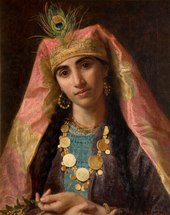Scheherazade

Scheherazade (also Schahrasad or Schehrezâd, from Persian شهرزاد, DMG Šahrzād , 'Daughter / Born of the Empire') is one of the main characters from the framework plot of the Persian Tales of the Arabian Nights . She is the daughter of the vizier of the Persian king Shahryâr ( Persian شهريار, DMG Šahryār , 'Friend of the Empire') who was betrayed by his wife. That she got involved with a black slave was a particularly shameful crime in his eyes. Convinced that there is no faithful woman on earth, Shahryâr resolves never to be deceived by a woman again. Therefore, every day he marries a new woman who he has killed the next morning.
To put an end to this hustle and bustle, Scheherazade has her father give herself to the king as wife. During the night she begins to tell the king a story, the plot of which is interrupted the next morning. Curious about the end of the story, King Shahryâr lets her live. Scheherazade is supported by her sister Dinharazade, who asks her every night for the continuation of the story or a new one.
This type of storytelling lasts over 1001 nights, during which Scheherazade gives birth to three children. In the end, King Shahryâr is convinced of his wife's loyalty and so impressed by her cleverness that he lets her live.
The story of Scheherazade and Schahryâr is based on an old Persian fairy tale collection called Persian هزار افسانه, DMG Hezār Afsāna , 'A thousand fairy tales' back.
Adaptations
- In 1888 Nikolai Rimski-Korsakow composed his tone poem Scheherazade ,
- In 1898 Maurice Ravel wrote the orchestral overture Shéhérazade, ouverture de féerie , the premiere of which did not take place until 1899,
- In 1903 Maurice Ravel composed a song cycle for voice and orchestra with the title Shéhérazade ,
- In 1948 Jules Supervielle wrote the play Shéhérazade ,
- In 1971 the subject was filmed with Claude Jade ,
- In 1975 the band Renaissance set the story to music on the album Scheherazade and Other Stories ,
- Another adaptation followed in 1990 with Catherine Zeta-Jones ,
- 1997–1998 the French animated series Sheherazade (Princesse Shéhérazade) was produced,
- In 2003 the ballet of the same name premiered in the Karlsruhe State Theater, choreographed by Ralf Jaroschinski ,
- In 2010, the artist Andrea Thema dedicated a staged room to her in the Women's Museum Bonn from December 2010 to April 2011: Klug wie Scheherazade,
- In 2015 John Adams wrote a Dramatic Symphony with an obligatory solo violin under the title Scheherazade. 2.
It is difficult to give an overview of their survival in literature, but Edgar Allan Poe's “The 1002nd Night of Scheherazade” (“The Thousand-and-Second Tale of Scheherazade”) should be mentioned, in which she presented the king with apparently wonderful things ( as a supplement to the Sindbad story), which are deciphered by means of footnotes as real phenomena / progress of the 19th century. Craig Shaw Gardner , an author of the genre humorous fantasy , parodies in the novel “Scheherazade makes stories” (“Sheherazade's night out”, 1992) above all the nested narration by introducing a multitude of narrative levels. The Bosnian author Dzevad Karahasan uses the template in “Schahrijars Ring” (“Šahrijarov prsten”, 1996) only indirectly to refer to the origins of narration and civilization, but does not allow either of the two main characters to appear.
Individual evidence
- ↑ Press release ( Memento of the original from April 16, 2015 in the Internet Archive ) Info: The archive link was inserted automatically and has not yet been checked. Please check the original and archive link according to the instructions and then remove this notice.